An Investigation of the Effects of Brain Fatigue on the Sustained Attention of Intelligent Coal Mine VDT Operators
Abstract
:1. Introduction
2. Materials and Methods
2.1. Experimental Equipment and Environment
2.2. Subject Selection
2.3. Experimental Materials
2.3.1. Karolinska Sleepiness Scale (KSS)
2.3.2. EEG Experimental Materials
2.3.3. Stimulus Material for Brain Fatigue Induction
2.4. Experimental Process
3. Results
3.1. Subjective Scale Data Analysis of Brain Fatigue
3.2. Objective Data Analysis of Brain Fatigue
3.2.1. Reaction Time and Accuracy Rate
3.2.2. Flicker Fusion Frequency
3.2.3. Heart Rate and Dermal Electric Variation
- Heart Rate Variation
- Dermal Electric Variation
3.2.4. Eye Tracking Data
3.3. EEG Data Analysis
3.3.1. ERP Analysis
- N1 waves induced by standard stimuli
- N1, P2, N2, LPC late waves under deviant stimuli
3.3.2. EEG Topographical Maps
4. Discussion
5. Conclusions
- (1)
- The eight indicators of reaction time, error rate, task duration, flicker fusion frequency, heart rate, electrodermal activity, blink frequency, and pupil diameter are sensitive to changes in cognitive VDT sustained operational brain fatigue, which could be combined with subjective scales as evaluation indicators for creating a comprehensive brain fatigue evaluation system.
- (2)
- The same experimental task’s ERP results demonstrate that N1, P200, N200, and LPC components are evoked, both before and after brain fatigue, and that the common brain regions associated with attentional activation are the frontal areas, especially the prefrontal, central, parietal, and temporal regions. The wave amplitude of the N100 component evoked by standard stimuli is significantly lower in the post-fatigue state than in the pre-fatigue state, showing a decrease in sustained attention; the wave amplitude of the P200 component evoked by deviant stimuli is significantly higher in the post-fatigue state than in the pre-fatigue state, showing that subjects need to expend more cognitive effort to maintain attentional stability; the amplitude of the LPC late wave is significantly lower, showing a decrease in sustained attentional stability. The significant decrease in LPC late wave amplitude also points to a decrease in sustained attentional stability. In other words, the sustained attention of VDT workers in intelligent mines decreases with the development of brain fatigue.
- (3)
- Brain fatigue is an important factor affecting sustained attention in cognitive VDT operations. As the work period progresses, the operator‘s brain load increases, resulting in a state of brain fatigue and a decrease in sustained attention and performance, and after the 45th and 90th minute of continuous work, both subjective and objective data suggest that the operator develops a more pronounced state of brain fatigue.
- (1)
- The study’s objects were VDT operators in intelligent mines, but the subjects were limited to VDT operators in one intelligent mine, so it remains to be verified whether the results of the study are generally representative. The experimental findings will be tested in the future by applying them to real-life situations in other intelligent mines.
- (2)
- Due to the specific nature of the work and in order to control the variables in the experiment, a simulated work-induced brain fatigue experiment was adopted, but there are some differences between the simulated VDT work and the real work. If the data could be coupled with real working conditions for 24 h real-time testing, the results would be more credible.
- (3)
- Although the study is internally controlled, no control group is set up, suggesting that similar effects do not exist when similar duration activities are carried out. Subsequent experiments should be set up with suitable control groups to ensure the preciseness of the data.
Author Contributions
Funding
Institutional Review Board Statement
Informed Consent Statement
Data Availability Statement
Conflicts of Interest
References
- Guo, J.Z.; Guo, J. Discussion on industrial internet technology framework of smart mine. Coal Sci. Technol. 2022, 50, 238–246. [Google Scholar]
- Gu, L.G.; Hang, F.R. Visual display terminal work management. Ind. Eng. J. 2003, 6, 10–14. [Google Scholar]
- Brito, G.D. Towards a model for the study of written procedure following in dynamic environments. Reliab. Eng. Syst. Saf. 2002, 75, 233–244. [Google Scholar] [CrossRef]
- Chuang, C.F.; Chou, H.P.; Chen, Y.B.; Shiao, H. Regulatory overview of digital I&C system in Taiwan Lungmen Project. Ann. Nucl. Energy. 2008, 35, 877–889. [Google Scholar]
- Zio, E. Reliability engineering: Old problems and new challenges. Reliab. Eng. Syst. Saf. 2009, 94, 125–141. [Google Scholar] [CrossRef]
- Tian, S.C.; Yang, P.F.; Tang, A.F. Definition and research significance of high probability near-miss in coal mine. J. Xi’an Univ. Sci. Technol. 2020, 40, 566–571. [Google Scholar]
- Shi, X.L.; Zhou, Z.Z.; Fu, G.Y. Analysis on multi-characterization of body fatigue based on Ergonomics. J. Qingdao Univ. Technol. 2013, 34, 102–106. [Google Scholar]
- Li, C.X.; Zhao, W.; Li, Q.; Ding, J.Z.; Zhao, L.C. Application of fatigue monitoring technology in smart mine safety management. Coal Sci. Technol. 2021, 49, 131–137. [Google Scholar]
- Boksem, M.A.S.; Meijman, T.F.; Lorist, M.M. Mental fatigue, motivation and action monitoring. Biol. Psychol. 2006, 72, 123–132. [Google Scholar] [CrossRef]
- Pattyn, N.; Neyt, X.; Henderickx, D.; Soetens, E. Psychophysiological investigation of vigilance decrement: Boredom or cognitive fatigue. Physiol. Behav. 2008, 93, 369–378. [Google Scholar] [CrossRef]
- Lorist, M.M.; Klein, M.; Nieuwenhuis, S.; Jong, R.D.; Mulder, G.; Meijman, T.F. Mental fatigue and task control: Planning and preparation. Psychophysiology 2000, 37, 614–625. [Google Scholar] [CrossRef] [PubMed]
- Lorist, M.M. Impact of top-down control during mental fatigue. Brain Res. 2008, 1232, 113–123. [Google Scholar] [CrossRef]
- Lorist, M.M.; Bezdan, E.; Caat, M.; Span, M.M.; Roerdink, J.B.T.M.; Maurits, N.M. The influence of mental fatigue and motivation on neural network dynamics; an EEG coherence study. Brain Res. 2009, 1270, 95–106. [Google Scholar] [CrossRef] [PubMed]
- Guo, F.; Wang, T.B.; Ning, Z.J.; Lv, W. Effects of monotony on work-related fatigue in the monotonous work. Ind. Eng. Manag. 2017, 22, 134–140. [Google Scholar]
- Li, J.N.; Song, G.P.; Zhao, D.N. Mental fatigue impairs pre-attentive change detection: An ERP study. Chin. J. Ergon. 2015, 21, 15–20. [Google Scholar]
- Cook, D.B.; O’Connor, P.J.; Lange, G.; Steffener, J. Functional neuroimaging correlates of mental fatigue induced by cognition among chronic fatigue syndrome patients and controls. NeuroImage 2007, 36, 108–122. [Google Scholar] [CrossRef]
- Zhang, L.; Zhao, M. Statistics and analysis of WANO human factor events. Nucl. Power Eng. 2005, 26, 291–296. [Google Scholar]
- Akerstedt, T.; Gillberg, M. Subjective and objective sleepiness in the active individual. Int. J. Neurosci. 1990, 52, 29–37. [Google Scholar] [CrossRef] [PubMed]
- Bishop, D.V.M.; Hardiman, M.J. Measurement of mismatch negativity in individuals: A study using single-trial analysis. Psychophysiology 2010, 47, 697–705. [Google Scholar] [CrossRef]
- Chung, K.F. Use of the Epworth Sleepiness Scale in Chinese patients with obstructive sleep apnea and normal hospital employees. J. Psychosom. Res. 2000, 49, 367–372. [Google Scholar] [CrossRef]
- Jian, Z.G. Research on the Effect of Mental Workload on Learning Efficiency. J. Shaanxi Norm. Univ. 2019, 48, 166–176. [Google Scholar]
- Schmidt, E.A.; Schrauf, M.; Simon, M.; Buchner, A.; Kincses, W.E. The short-term effect of verbally assessing drivers’ state on vigilance indices during monotonous daytime driving. Transp. Res. Part F Traffic Psychol. Behav. 2011, 14, 251–260. [Google Scholar] [CrossRef]
- Carter, L.; Russell, P.N.; Helton, W.S. Target predictability, sustained attention, and response inhibition. Brain Cogn. 2013, 82, 35–42. [Google Scholar] [CrossRef]
- Shalev, L.; Ben-Simon, A.; Mevorach, C.; Cohen, Y.; Tsal, Y. Conjunctive continuous performance task (CCPT)-A pure measure of sustained attention. Neuropsychologia 2011, 49, 2584–2591. [Google Scholar] [CrossRef]
- Shen, W.Y.; Leng, Y.; Yu, Z.Y. The roles of symbolic and numerical representations in asymmetric visual search. Acta Psychol. 2021, 219, 103397. [Google Scholar] [CrossRef] [PubMed]
- Smilek, D.; Carriere, J.S.A.; Cheyne, J.A. Out of mind, out of sight: Eye blinking as indicator and embodiment of mind wandering. J. Gerontol. 2010, 21, 786–789. [Google Scholar] [CrossRef] [PubMed]
- Bristow, D.; Haynes, J.D.; Sylvester, R.; Frith, C.D.; Rees, G. Blinking suppresses the neural response to unchanging retinal stimulation. Curr. Biol. 2005, 15, 1296–1300. [Google Scholar] [CrossRef]
- Grau, C.; Fuentemilla, L.; Marco-Pallarés, J. Functional neural dynamics underlying auditory event-related N1 and N1 suppression response. Neuroimage 2007, 36, 522–531. [Google Scholar] [CrossRef]
- Woldorff, M.G.; Hillyard, S.A. Modulation of early auditory processing during selective listening to rapidly presented tones. Electroencephalogr. Clin. Neurophysiol. 1991, 79, 170–191. [Google Scholar] [CrossRef]
- Slagter, H.A.; Prinssen, S.; Reteig, L.C.; Mazaheri, A. Facilitation and inhibition in attention: Functional dissociation of pre-stimulus alpha activity, P1, and N1 components. Neuroimage 2016, 125, 25–35. [Google Scholar] [CrossRef] [Green Version]
- Näätänen, R.; Picton, T. The N1 wave of the human electric and magnetic response to sound: A review and an analysis of the component structure. Psychophysiology 1987, 24, 375–425. [Google Scholar] [CrossRef] [PubMed]
- Colrain, I.M.; Campbell, K.B. The use of evoked potentials in sleep research. Sleep Med. Rev. 2007, 11, 277–293. [Google Scholar] [CrossRef] [PubMed]
- Luo, Y.Y.; Sun, R.; Wang, Y.X.; Wei, Z.Y. Cognitive Resources: A New Perspective to Explain Social Facilitation. J. Gerontol. 2021, 44, 1049–1056. [Google Scholar]
- Eimer, M. The time course of spatial orienting elicited by central and peripheral cues: Evidence from event-related brain potentials. Biol. Psychol. 2000, 53, 253–258. [Google Scholar] [CrossRef]
- Slagter, H.A.; Kok, A.; Mol, N.; Kenemans, J.L. Spatio-temporal dynamics of top-down control: Directing attention to location and/or color as revealed by ERPs and source modeling. Cognit. Brain Res. 2005, 22, 333–348. [Google Scholar] [CrossRef] [PubMed]
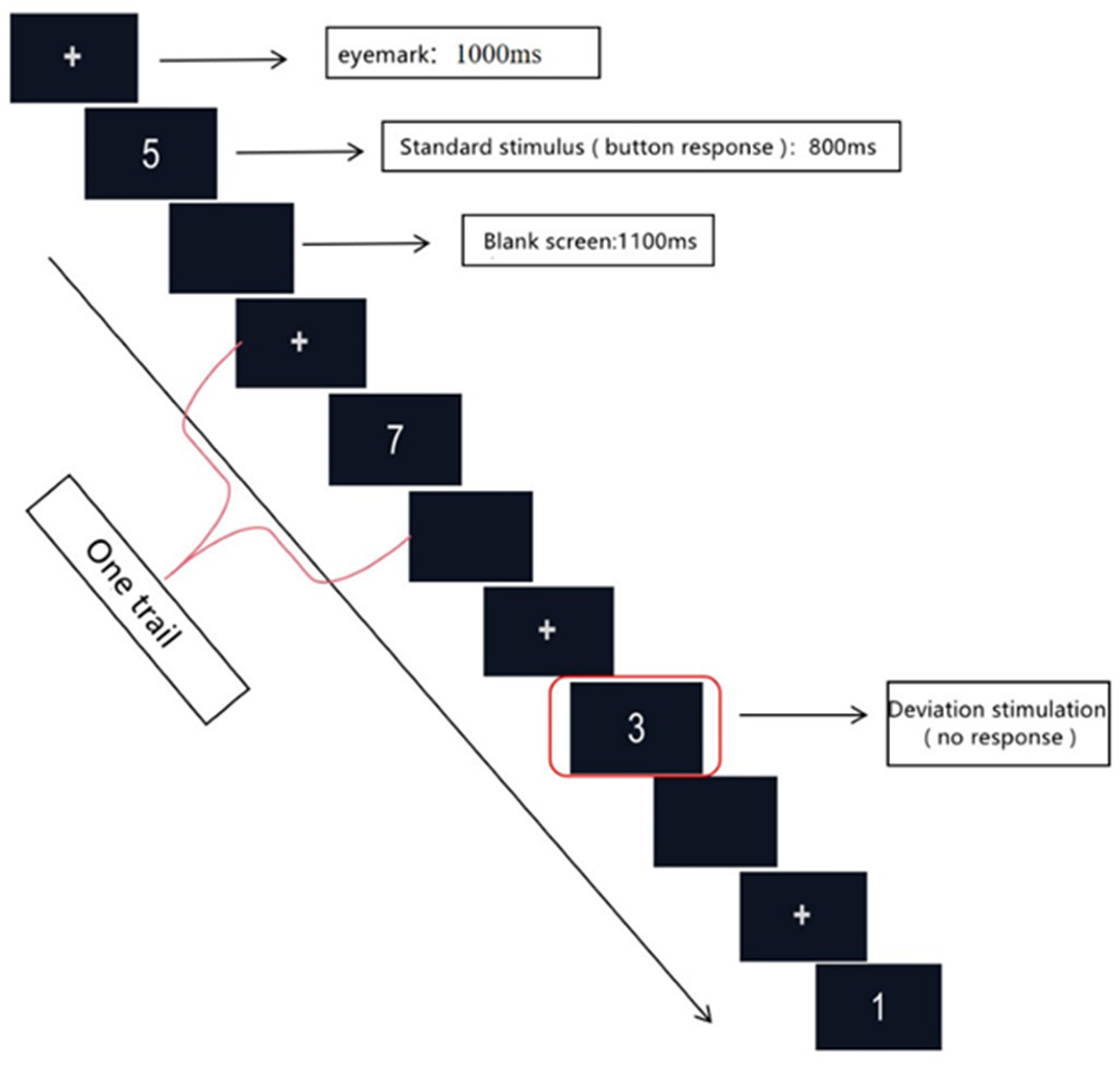
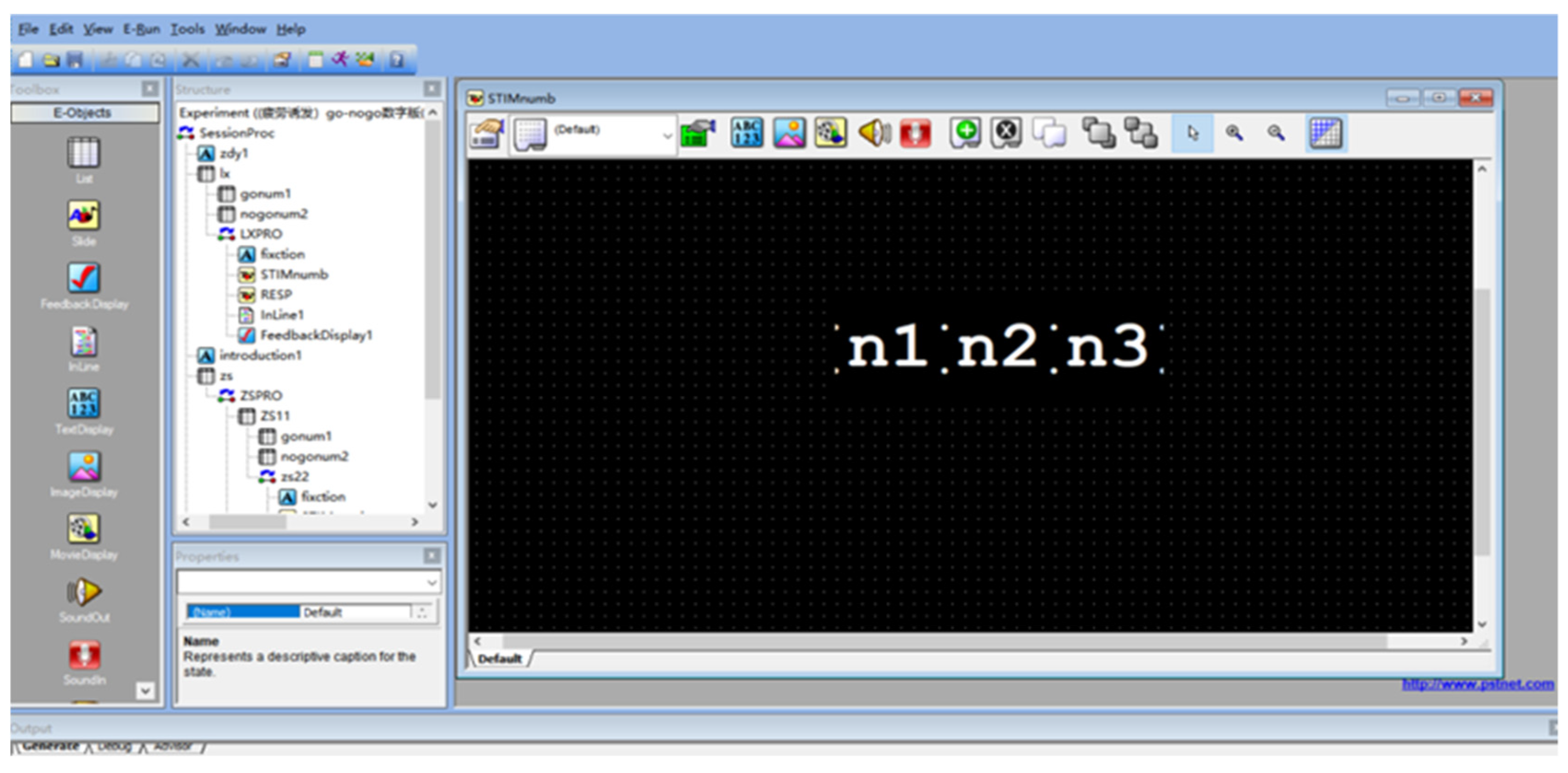


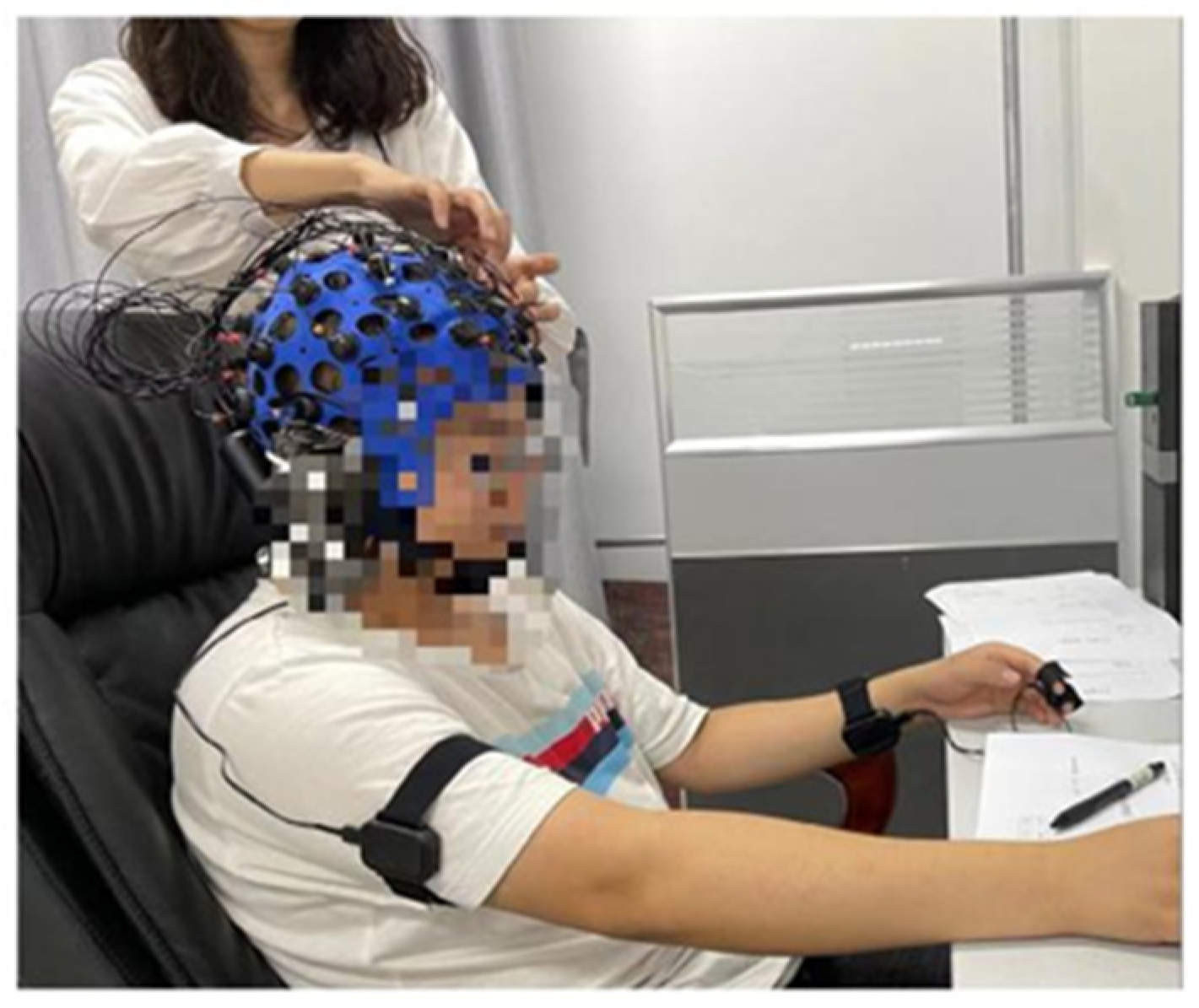
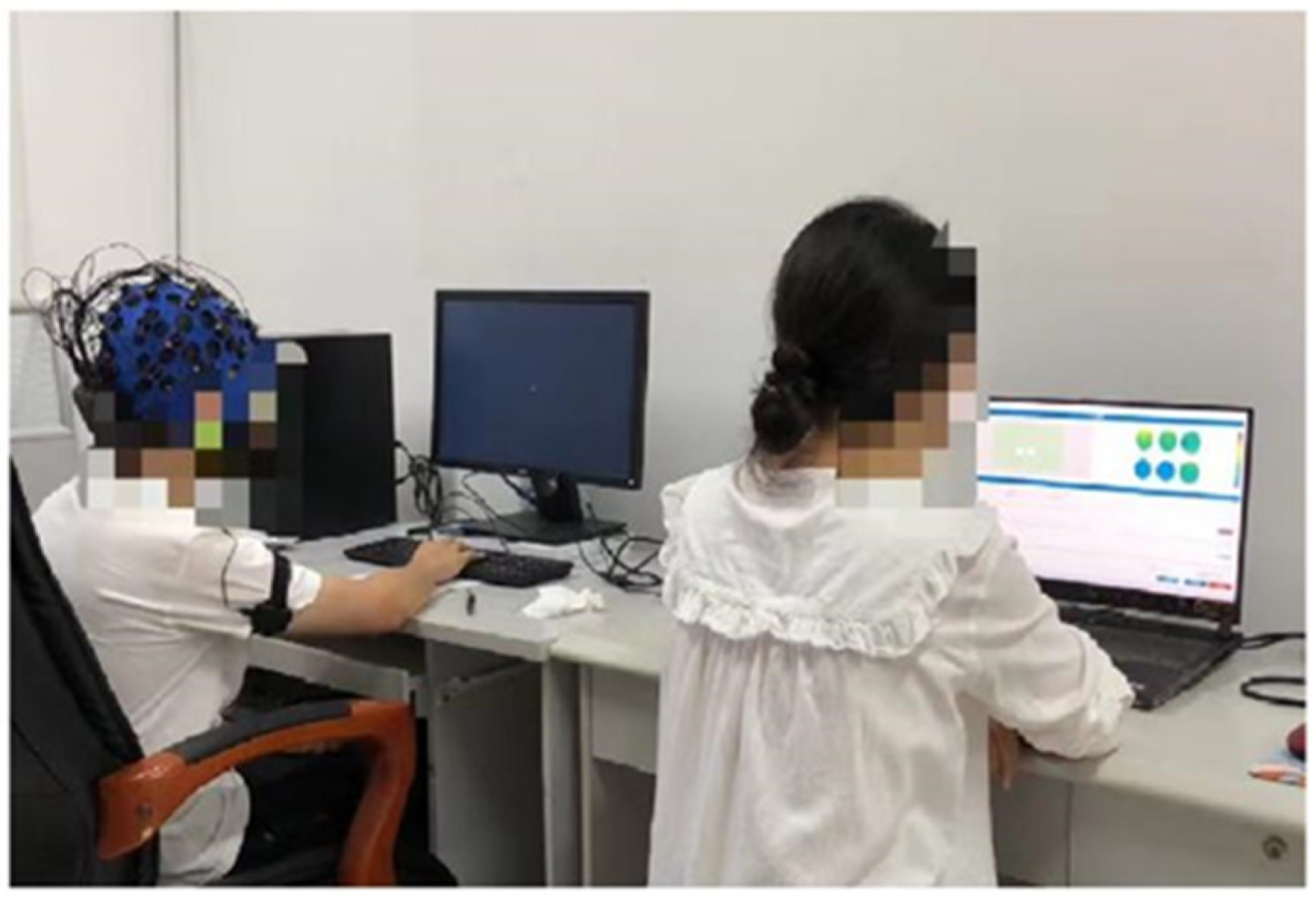

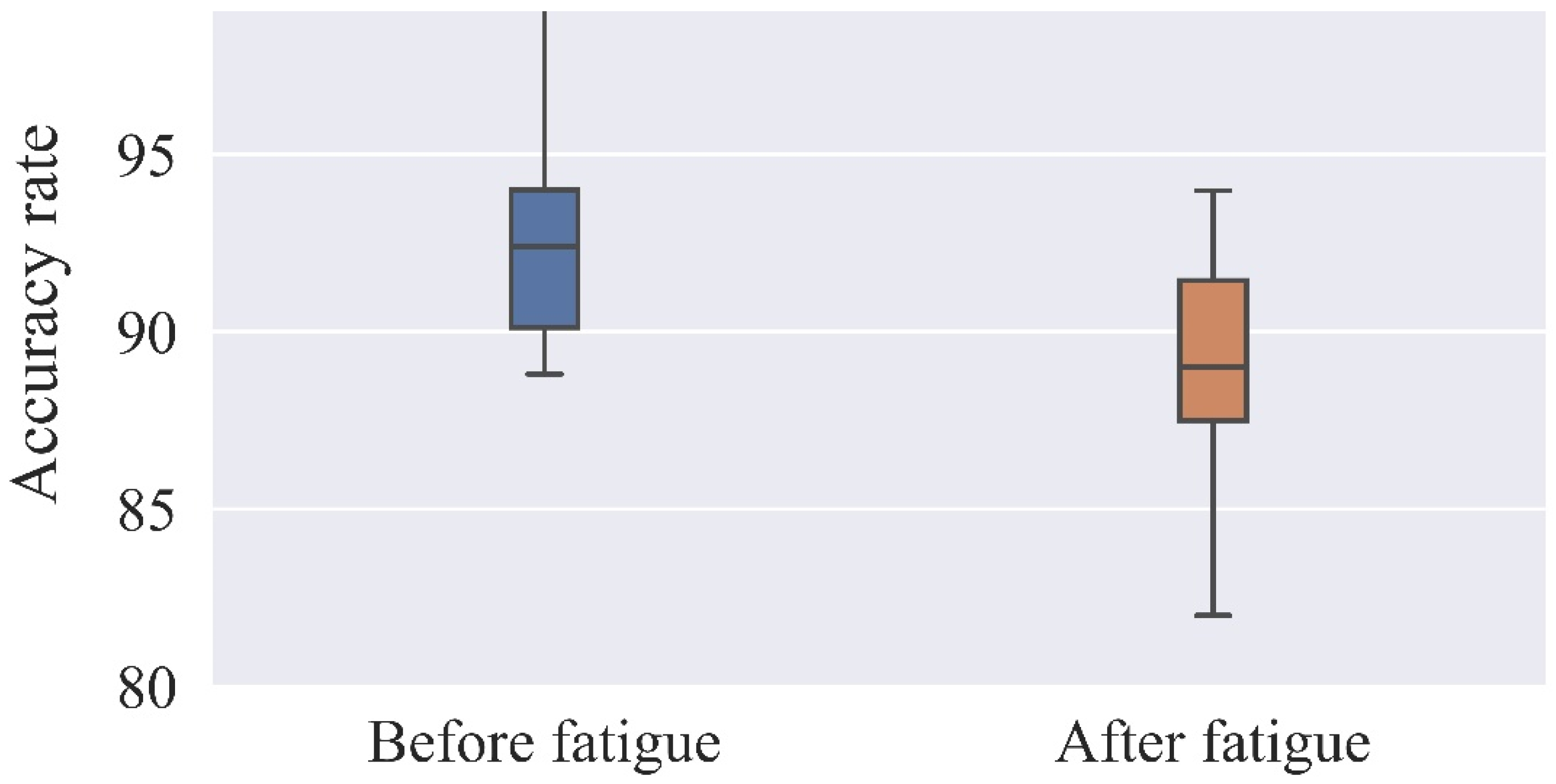
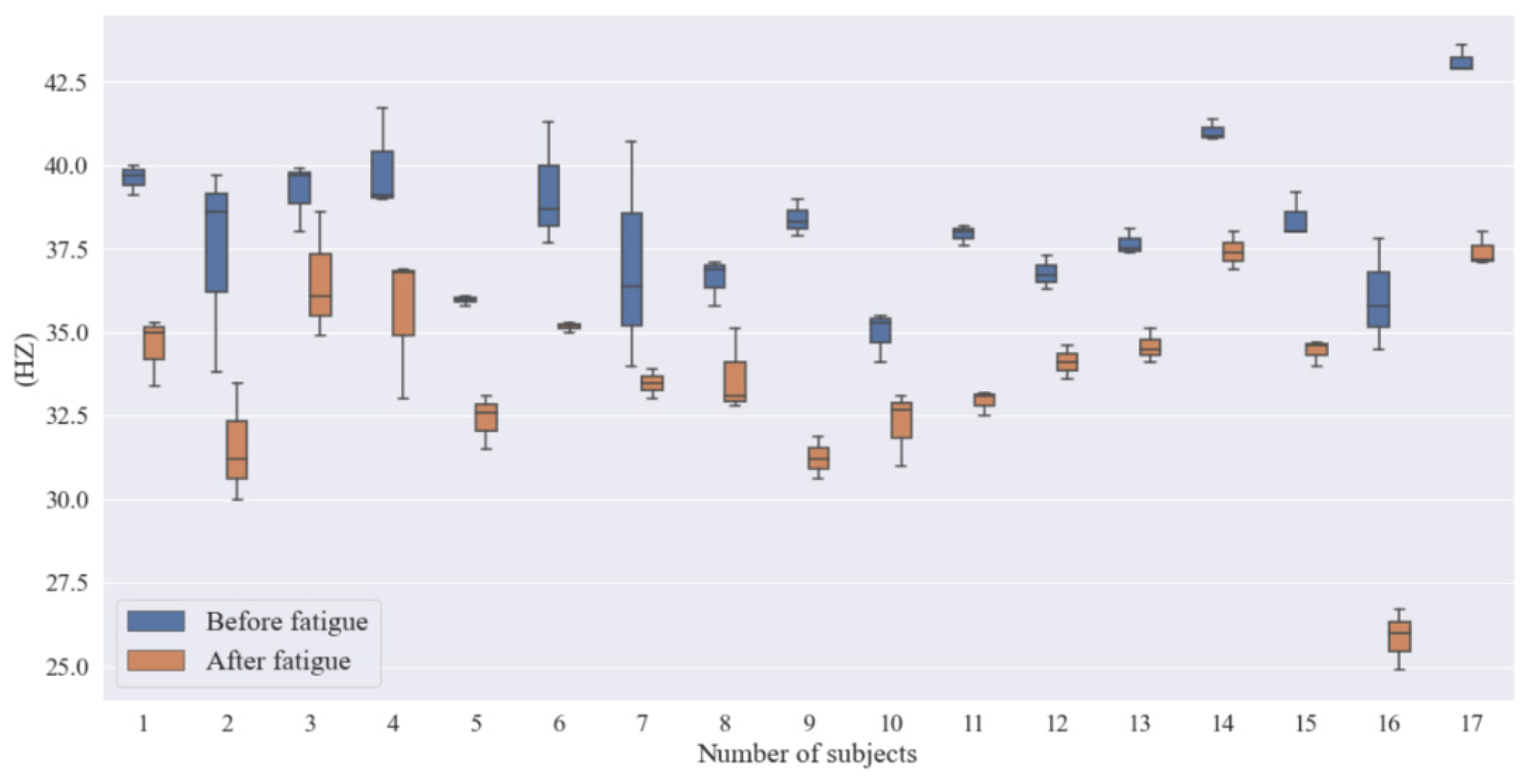
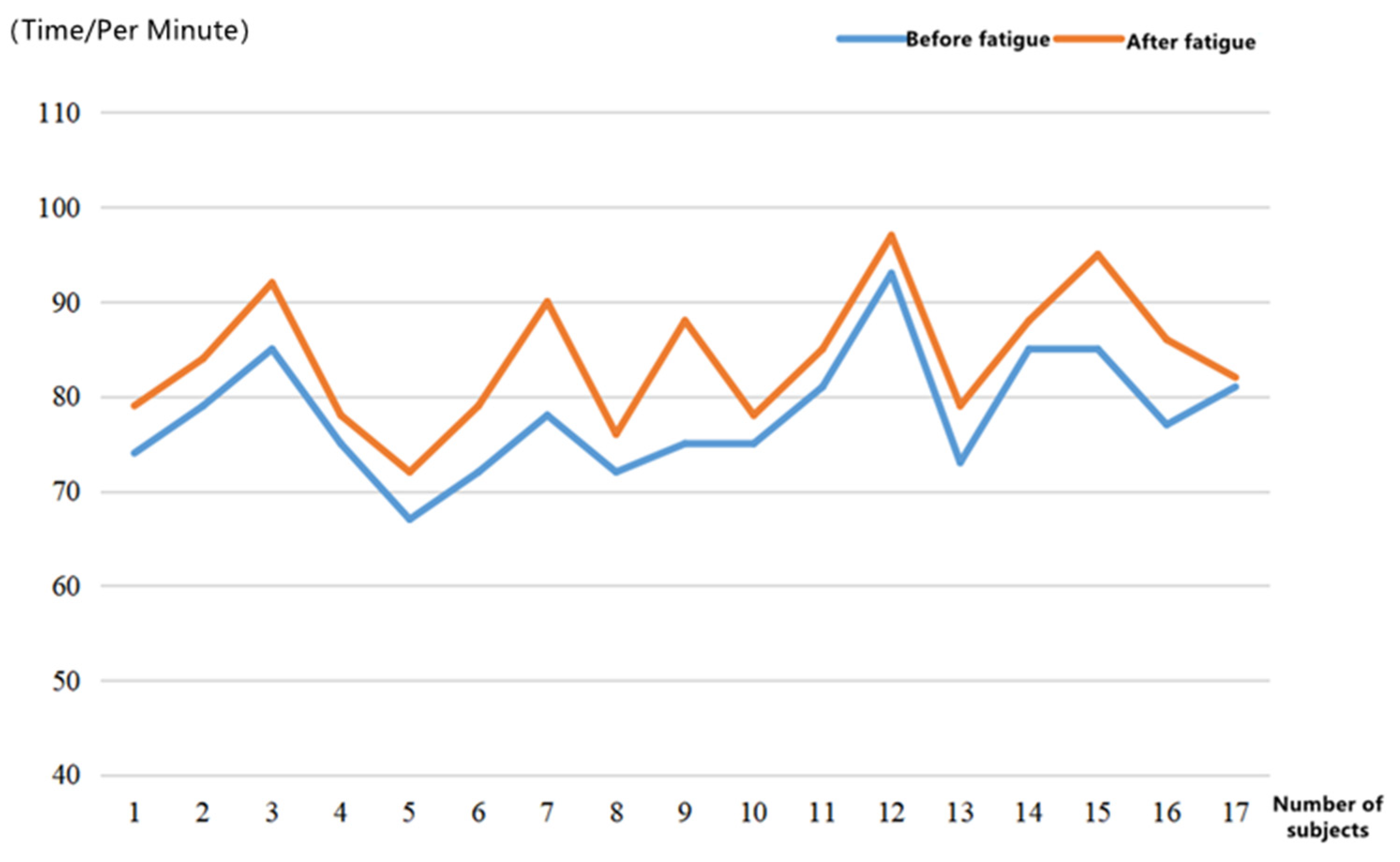

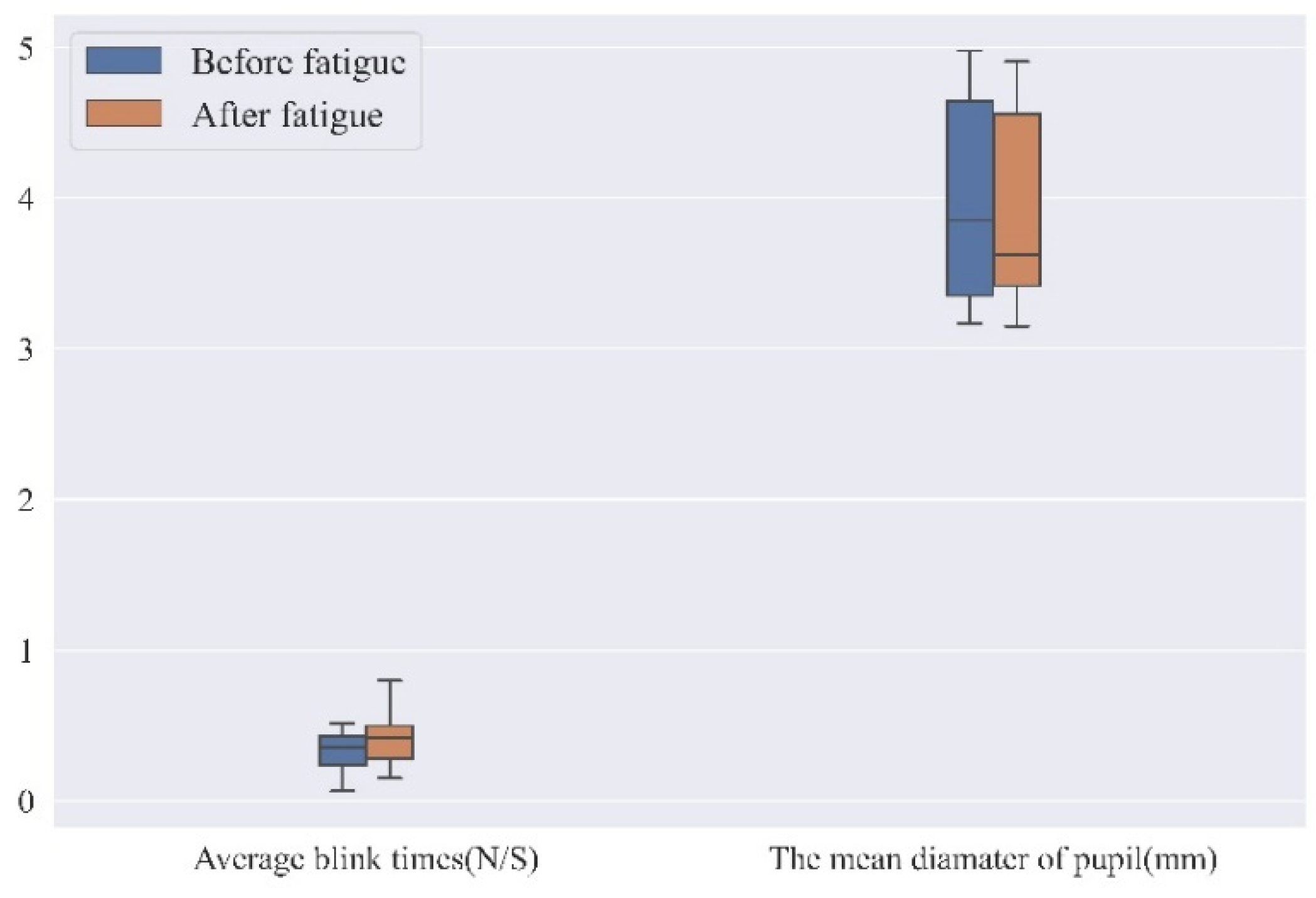
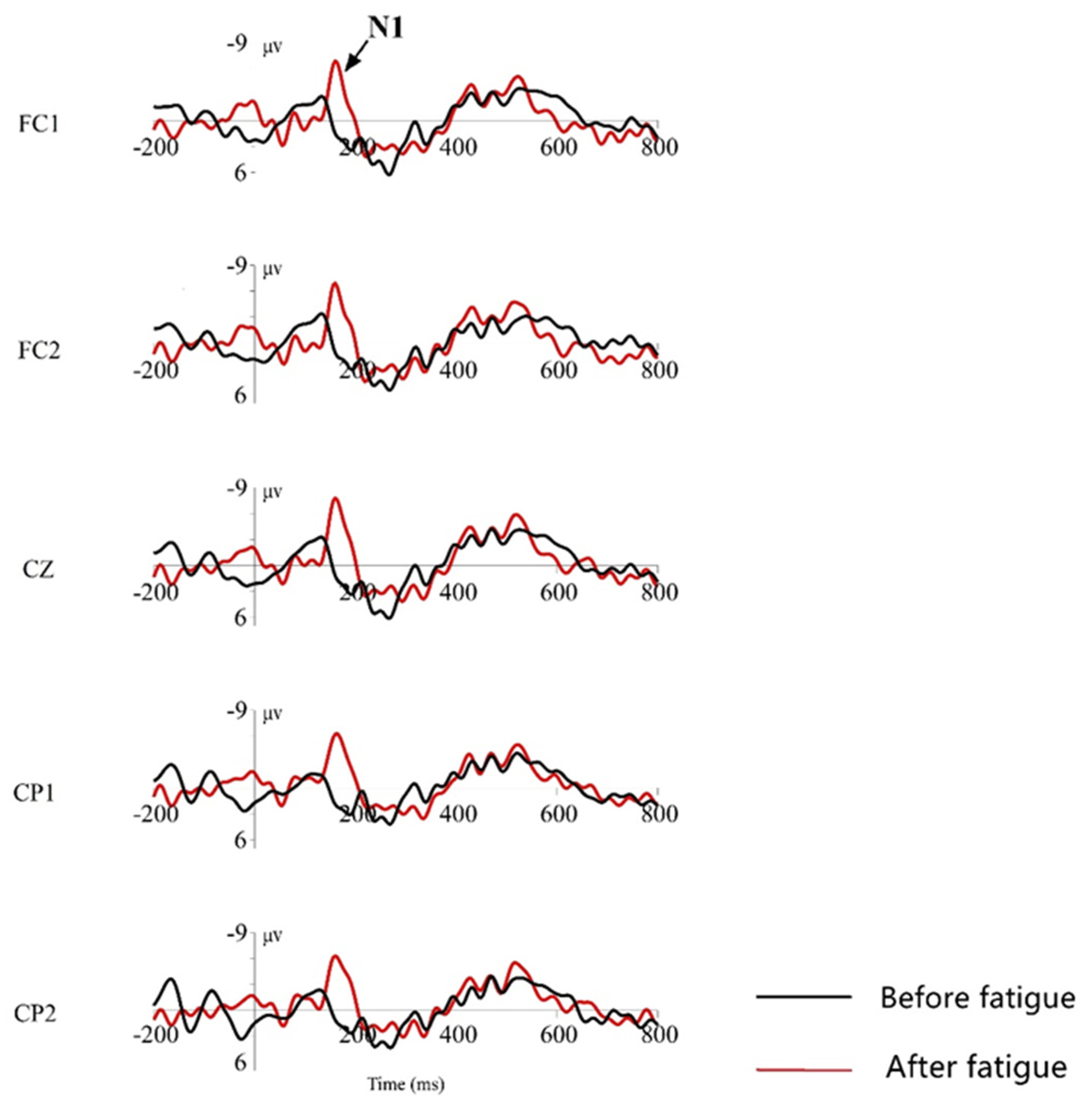
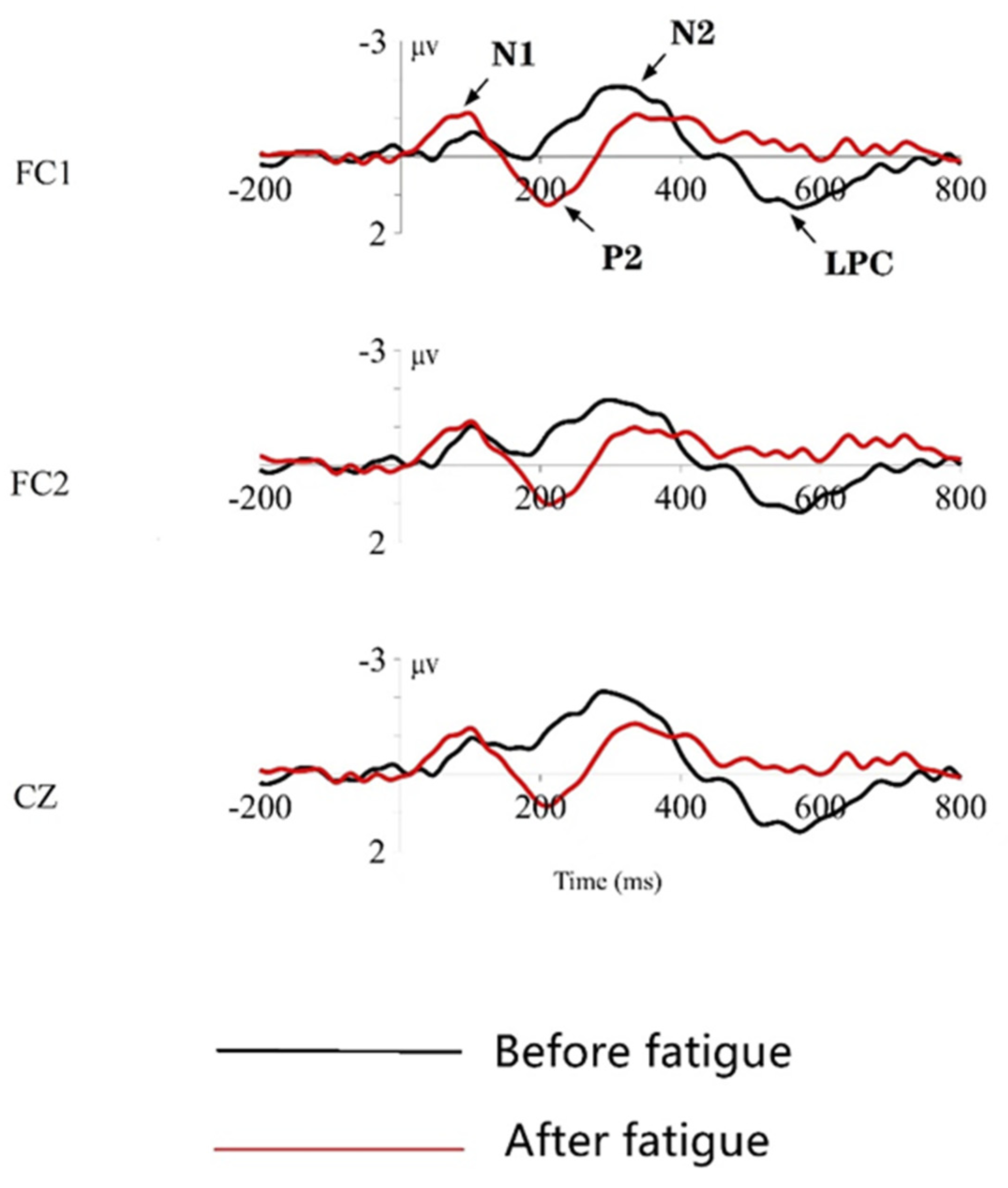
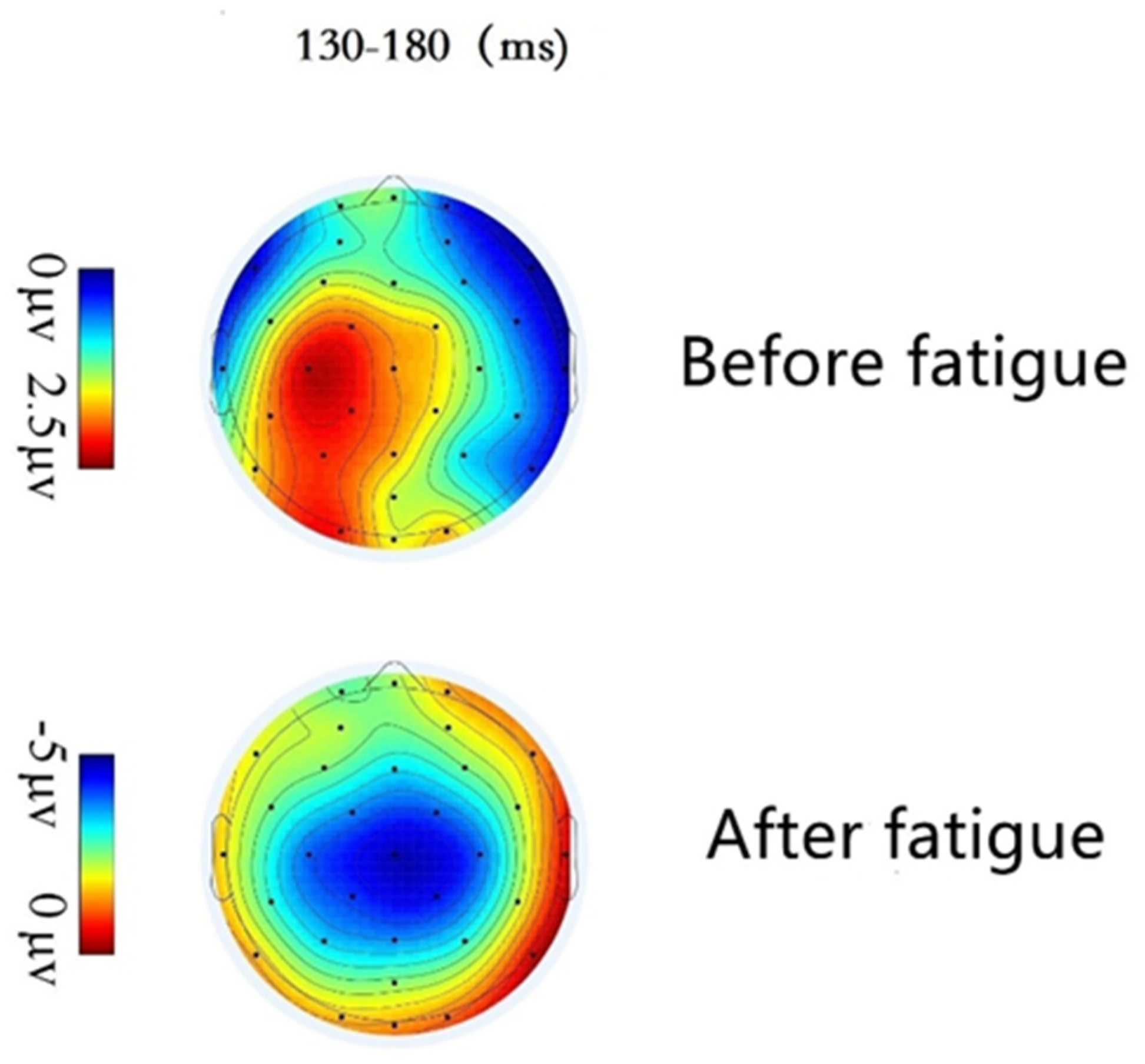
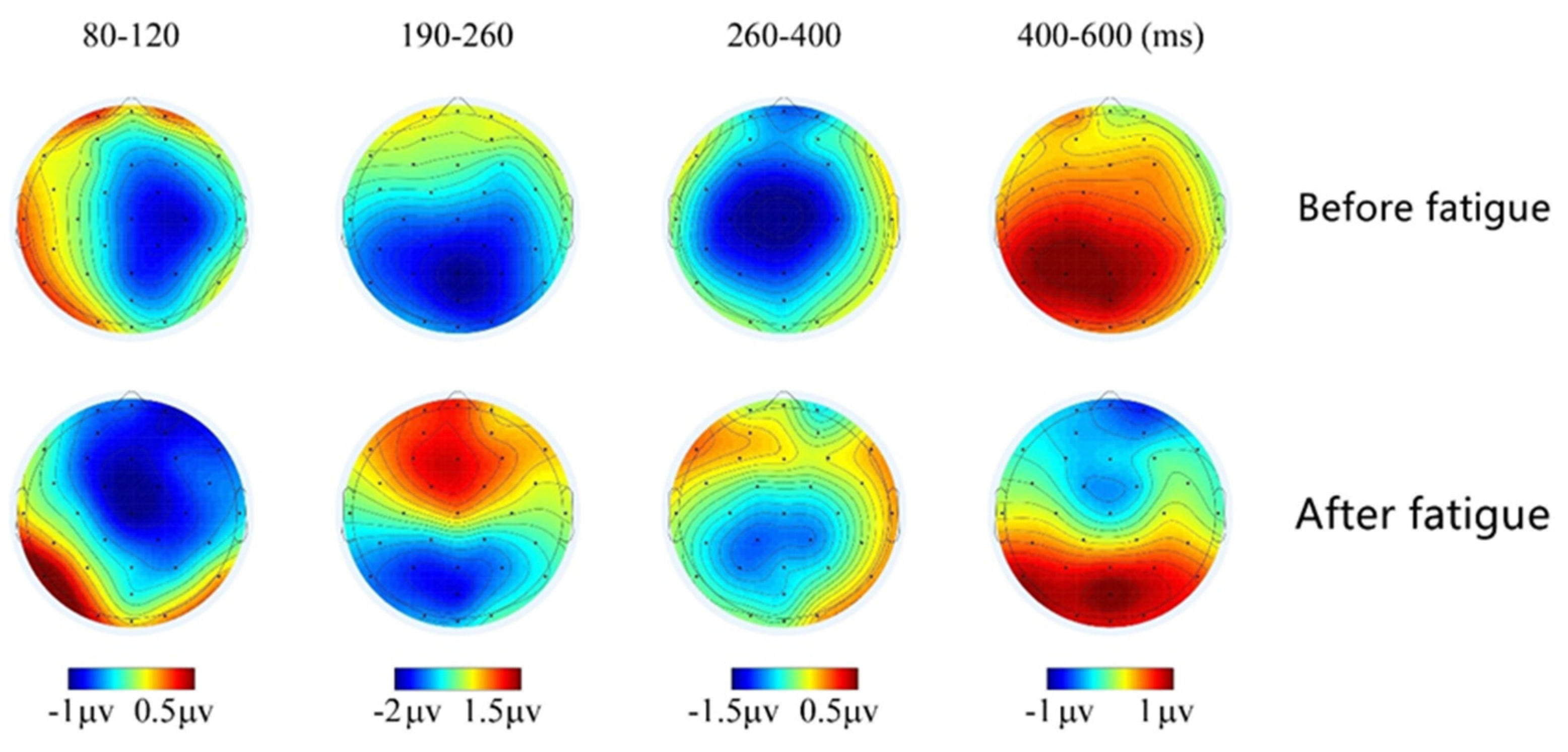

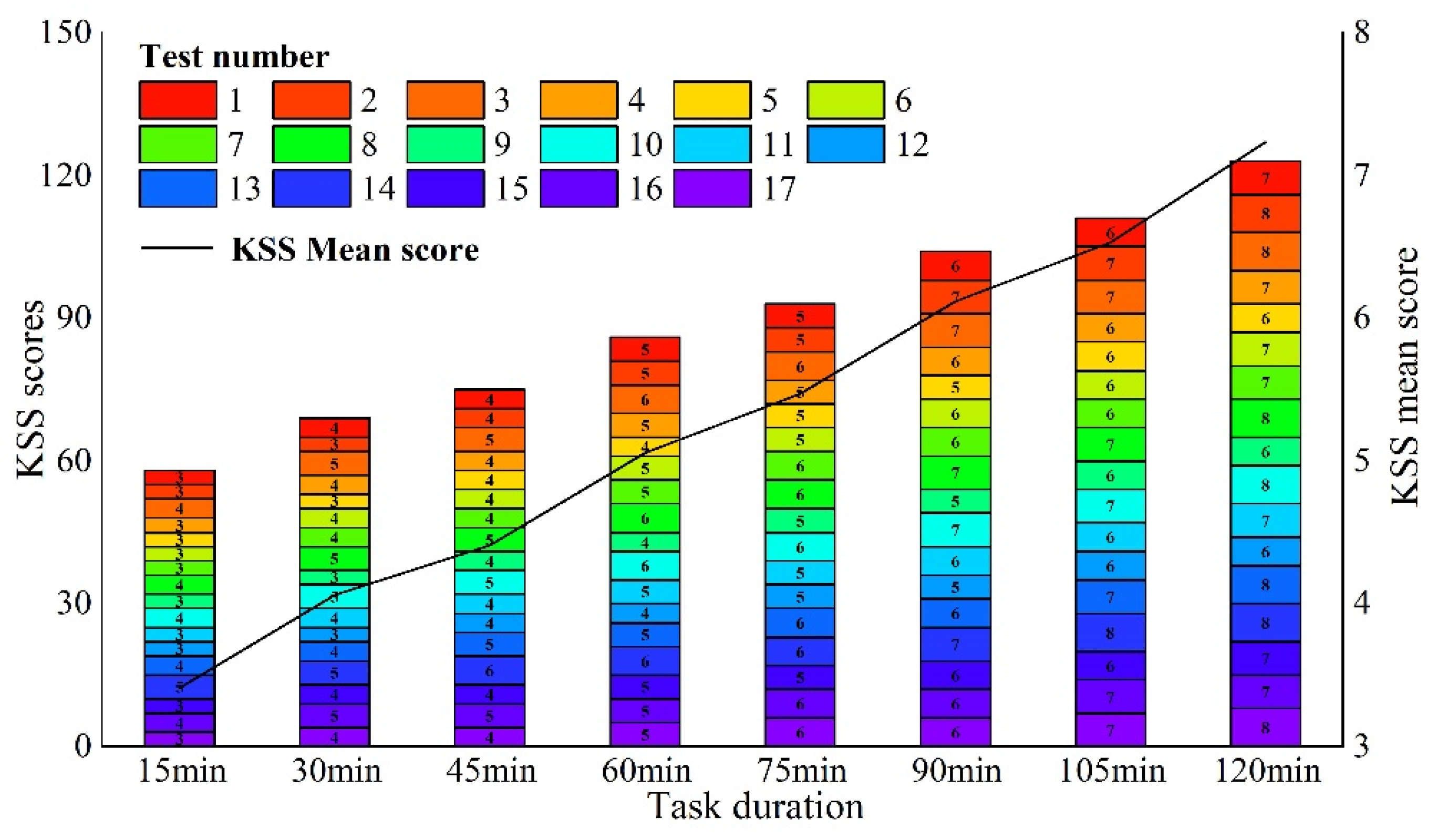
| Continuous Performance Test (VDT) | Signal Rate | The Number of Trails |
|---|---|---|
| Operating conditions: N1 + N2 − N3 = N4, N4 ∈ [7, 13] | 1:2 | 600 |
| Response: Press P if in the interval; Press Q otherwise | ||
| No response beyond 5000 ms: Miss |
| Examinee | Before | After | Examinee | Before | After | Examinee | Before | After |
|---|---|---|---|---|---|---|---|---|
| 1 | 3 | 6 | 7 | 3 | 6 | 13 | 3 | 8 |
| 2 | 3 | 7 | 8 | 4 | 8 | 14 | 5 | 8 |
| 3 | 3 | 6 | 9 | 3 | 7 | 15 | 3 | 7 |
| 4 | 3 | 7 | 10 | 3 | 7 | 16 | 4 | 8 |
| 5 | 3 | 8 | 11 | 3 | 7 | 17 | 3 | 8 |
| 6 | 3 | 7 | 12 | 3 | 7 |
| Mean | Std. Deviation | Std. Error Mean | t | df | Sig. (2-Tailed) | |
|---|---|---|---|---|---|---|
| After fatigue–Before fatigue | −3.941 | 0.659 | 0.160 | −24.671 | 16 | 0.000 |
| Mental Fatigue State | Mean |
|---|---|
| Before fatigue | 3.24 ± 0.562 |
| After fatigue | 7.18 ± 0.728 |
| Mean | Std. Deviation | Std. Error Mean | t | df | Sig. (2-Tailed) | |
|---|---|---|---|---|---|---|
| After fatigue–Before fatigue | −42.451 | 49.832 | 12.086 | −3.512 | 16 | 0.04 |
| Mean | Std. Deviation | Std. Error Mean | t | df | Sig. (2-Tailed) | |
|---|---|---|---|---|---|---|
| After fatigue–Before fatigue | −42.261 | 49.620 | 12.034 | 2.407 | 16 | 0.029 |
| Before Fatigue | After Fatigue | ||||||||
|---|---|---|---|---|---|---|---|---|---|
| Examinee | First (HZ) | Second (HZ) | Third (HZ) | Mean (HZ) | Examinee | First (HZ) | Second (HZ) | Third (HZ) | Mean (HZ) |
| 1 | 39.10 | 39.70 | 40.00 | 39.60 | 1 | 33.40 | 35.00 | 35.30 | 34.57 |
| 2 | 38.60 | 33.80 | 39.70 | 36.75 | 2 | 31.20 | 33.50 | 30.00 | 31.57 |
| 3 | 39.70 | 38.00 | 39.90 | 39.20 | 3 | 36.10 | 38.60 | 34.90 | 36.53 |
| 4 | 39.10 | 39.00 | 41.70 | 40.35 | 4 | 33.00 | 36.80 | 36.90 | 35.57 |
| 5 | 36.00 | 35.80 | 36.10 | 35.97 | 5 | 33.10 | 32.60 | 31.50 | 32.40 |
| 6 | 38.70 | 41.30 | 37.70 | 39.50 | 6 | 35.00 | 35.30 | 35.20 | 35.17 |
| 7 | 36.40 | 40.70 | 34.00 | 37.03 | 7 | 33.00 | 33.90 | 33.50 | 33.47 |
| 8 | 36.90 | 35.80 | 37.10 | 36.45 | 8 | 32.80 | 33.10 | 35.10 | 33.67 |
| 9 | 38.30 | 39.00 | 37.90 | 38.40 | 9 | 31.90 | 31.20 | 30.60 | 31.23 |
| 10 | 34.10 | 35.50 | 35.30 | 35.40 | 10 | 33.10 | 32.70 | 31.00 | 32.27 |
| 11 | 38.20 | 38.00 | 37.60 | 37.93 | 11 | 33.20 | 32.50 | 33.10 | 32.93 |
| 12 | 36.70 | 36.30 | 37.30 | 36.80 | 12 | 34.10 | 33.60 | 34.60 | 34.10 |
| 13 | 37.50 | 37.40 | 38.10 | 37.67 | 13 | 35.10 | 34.50 | 34.10 | 34.57 |
| 14 | 41.40 | 40.80 | 40.90 | 40.85 | 14 | 37.40 | 38.00 | 36.90 | 37.43 |
| 15 | 38.00 | 39.20 | 38.00 | 38.40 | 15 | 34.60 | 34.70 | 34.00 | 34.43 |
| 16 | 37.80 | 35.80 | 34.50 | 36.03 | 16 | 24.90 | 26.70 | 26.00 | 25.87 |
| 17 | 43.60 | 42.90 | 42.90 | 43.13 | 17 | 37.10 | 37.20 | 38.00 | 37.43 |
| Mean | Std. Deviation | Std. Error Mean | t | df | Sig. (2-Tailed) | |
|---|---|---|---|---|---|---|
| After fatigue–Before fatigue | 4.486 | 1.910 | 0.463 | 9.687 | 16 | 0.000 |
| Mean | Std. Deviation | Std. Error Mean | t | df | Sig. (2-Tailed) | |
|---|---|---|---|---|---|---|
| After fatigue–Before fatigue | −5.941 | 3.344 | 0.811 | −7.325 | 16 | 0.000 |
| Examinee | Before | After | Examinee | Before | After | Examinee | Before | After |
|---|---|---|---|---|---|---|---|---|
| 1 | 7.88 | 9.17 | 7 | 0.49 | 0.56 | 13 | 7.42 | 7.88 |
| 2 | 4.47 | 10.69 | 8 | 1.14 | 0.65 | 14 | 5.45 | 6.63 |
| 3 | 6.35 | 10.05 | 9 | 0.47 | 0.81 | 15 | 3.28 | 3.87 |
| 4 | 8.18 | 13 | 10 | 2.23 | 3.73 | 16 | 2.59 | 4.07 |
| 5 | 0.49 | 1.33 | 11 | 0.39 | 0.67 | 17 | 4.27 | 5.67 |
| 6 | 0.36 | 0.75 | 12 | 2.06 | 3.26 |
| Mean | Std. Deviation | Std. Error Mean | t | df | Sig. (2-Tailed) | |
|---|---|---|---|---|---|---|
| After fatigue–Before fatigue | 1.48647 | 1.78187 | 0.43217 | 3.427 | 16 | 0.003 |
| Paired Differences | t | df | Sig. | ||||
|---|---|---|---|---|---|---|---|
| Mean | Std. Deviation | Std. Error Mean | |||||
| Standard stimulus | N1(B-A) | −6.246 | 9.921 | 2.651 | 2.356 | 13 | 0.035 |
| Deviant stimulation | N1(B-A) | 0.265 | 1.567 | 0.419 | 0.633 | 13 | 0.538 |
| P2(B-A) | −1.766 | 2.867 | 0.766 | −2.305 | 13 | 0.038 | |
| N2(B-A) | −0.788 | 2.496 | 0.667 | −1.181 | 13 | 0.259 | |
| LPC(B-A) | 1.029 | 0.648 | 0.173 | 5.942 | 13 | 0.000 | |
| 15 min | 30 min | 45 min | 60 min | 75 min | 90 min | 105 min | 120 min | |
|---|---|---|---|---|---|---|---|---|
| Reaction time (ms) | 1340 | 1398 | 1499 | 1623 | 1731 | 1822 | 2095 | 2156 |
| Accuracy (%) | 96.30 | 95.86 | 94.22 | 92.13 | 91.51 | 91.28 | 87.07 | 86.39 |
| Missing report rate (%) | 0.000 | 0.013 | 0.019 | 0.025 | 0.036 | 0.042 | 0.059 | 0.060 |
| CFF (HZ) | 38.19 | 37.70 | 37.21 | 36.69 | 36.03 | 35.41 | 33.98 | 33.70 |
| Score of KSS scale (fraction) | 3.41 | 4.06 | 4.41 | 5.06 | 5.47 | 6.12 | 6.53 | 7.24 |
Publisher’s Note: MDPI stays neutral with regard to jurisdictional claims in published maps and institutional affiliations. |
© 2022 by the authors. Licensee MDPI, Basel, Switzerland. This article is an open access article distributed under the terms and conditions of the Creative Commons Attribution (CC BY) license (https://creativecommons.org/licenses/by/4.0/).
Share and Cite
Sun, L.; Guo, Z.; Yuan, X.; Wang, X.; Su, C.; Jiang, J.; Li, X. An Investigation of the Effects of Brain Fatigue on the Sustained Attention of Intelligent Coal Mine VDT Operators. Int. J. Environ. Res. Public Health 2022, 19, 11034. https://doi.org/10.3390/ijerph191711034
Sun L, Guo Z, Yuan X, Wang X, Su C, Jiang J, Li X. An Investigation of the Effects of Brain Fatigue on the Sustained Attention of Intelligent Coal Mine VDT Operators. International Journal of Environmental Research and Public Health. 2022; 19(17):11034. https://doi.org/10.3390/ijerph191711034
Chicago/Turabian StyleSun, Linhui, Zigu Guo, Xiaofang Yuan, Xinping Wang, Chang Su, Jiali Jiang, and Xun Li. 2022. "An Investigation of the Effects of Brain Fatigue on the Sustained Attention of Intelligent Coal Mine VDT Operators" International Journal of Environmental Research and Public Health 19, no. 17: 11034. https://doi.org/10.3390/ijerph191711034
APA StyleSun, L., Guo, Z., Yuan, X., Wang, X., Su, C., Jiang, J., & Li, X. (2022). An Investigation of the Effects of Brain Fatigue on the Sustained Attention of Intelligent Coal Mine VDT Operators. International Journal of Environmental Research and Public Health, 19(17), 11034. https://doi.org/10.3390/ijerph191711034





